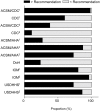Confusion and conflict in assessing the physical activity status of middle-aged men
- PMID: 19183812
- PMCID: PMC2629570
- DOI: 10.1371/journal.pone.0004337
Confusion and conflict in assessing the physical activity status of middle-aged men
Abstract
Background: Physical activity (including exercise) is prescribed for health and there are various recommendations that can be used to gauge physical activity status. The objective of the current study was to determine whether twelve commonly-used physical activity recommendations similarly classified middle-aged men as sufficiently active for general health.
Methods and findings: We examined the commonality in the classification of physical activity status between twelve variations of physical activity recommendations for general health in ninety men aged 45-64 years. Physical activity was assessed using synchronised accelerometry and heart rate. Using different guidelines but the same raw data, the proportion of men defined as active ranged from to 11% to 98% for individual recommendations (median 73%, IQR 30% to 87%). There was very poor absolute agreement between the recommendations, with an intraclass correlation coefficient (A,1) of 0.24 (95% CI, 0.15 to 0.34). Only 8% of men met all 12 recommendations and would therefore be unanimously classified as active and only one man failed to meet every recommendation and would therefore be unanimously classified as not sufficiently active. The wide variability in physical activity classification was explained by ostensibly subtle differences between the 12 recommendations for thresholds related to activity volume (time or energy), distribution (e.g., number of days of the week), moderate intensity cut-point (e.g., 3 vs. 4 metabolic equivalents or METs), and duration (including bout length).
Conclusions: Physical activity status varies enormously depending on the physical activity recommendation that is applied and even ostensibly small differences have a major impact. Approximately nine out of every ten men in the present study could be variably described as either active or not sufficiently active. Either the effective dose or prescription that underlies each physical activity recommendation is different or each recommendation is seeking the same prescriptive outcome but with variable success.
Conflict of interest statement
Figures


Similar articles
-
Absolute and relative accelerometer thresholds for determining the association between physical activity and metabolic syndrome in the older adults: The Generation-100 study.BMC Geriatr. 2017 May 16;17(1):109. doi: 10.1186/s12877-017-0497-1. BMC Geriatr. 2017. PMID: 28511695 Free PMC article.
-
Light and sporadic physical activity overlooked by current guidelines makes older women more active than older men.Int J Behav Nutr Phys Act. 2017 May 2;14(1):59. doi: 10.1186/s12966-017-0519-6. Int J Behav Nutr Phys Act. 2017. PMID: 28464833 Free PMC article.
-
No. 367-2019 Canadian Guideline for Physical Activity throughout Pregnancy.J Obstet Gynaecol Can. 2018 Nov;40(11):1528-1537. doi: 10.1016/j.jogc.2018.07.001. Epub 2018 Oct 5. J Obstet Gynaecol Can. 2018. PMID: 30297272
-
Recommended levels of physical activity to avoid adiposity in Spanish children.Pediatr Obes. 2013 Feb;8(1):62-9. doi: 10.1111/j.2047-6310.2012.00086.x. Epub 2012 Sep 7. Pediatr Obes. 2013. PMID: 22961693
-
Weight status and perception barriers to healthy physical activity and diet behavior.Int J Obes (Lond). 2008 Feb;32(2):343-52. doi: 10.1038/sj.ijo.0803707. Epub 2007 Aug 7. Int J Obes (Lond). 2008. PMID: 17684508
Cited by
-
A cross-sectional study of physical activity and sedentary behaviours in a Caribbean population: combining objective and questionnaire data to guide future interventions.BMC Public Health. 2016 Oct 1;16(1):1036. doi: 10.1186/s12889-016-3689-2. BMC Public Health. 2016. PMID: 27716210 Free PMC article.
-
Feedback from physical activity monitors is not compatible with current recommendations: A recalibration study.Prev Med. 2016 Oct;91:389-394. doi: 10.1016/j.ypmed.2016.06.017. Epub 2016 Jun 18. Prev Med. 2016. PMID: 27330025 Free PMC article.
-
Multidimensional physical activity: an opportunity, not a problem.Exerc Sport Sci Rev. 2015 Apr;43(2):67-74. doi: 10.1249/JES.0000000000000039. Exerc Sport Sci Rev. 2015. PMID: 25607280 Free PMC article. Review.
-
Awareness of physical activity in healthy middle-aged adults: a cross-sectional study of associations with sociodemographic, biological, behavioural, and psychological factors.BMC Public Health. 2014 May 2;14:421. doi: 10.1186/1471-2458-14-421. BMC Public Health. 2014. PMID: 24886612 Free PMC article.
-
Responsiveness of Device-Based and Self-Report Measures of Physical Activity to Detect Behavior Change in Men Taking Part in the Football Fans in Training (FFIT) Program.J Meas Phys Behav. 2020 Mar;3(1):67-77. doi: 10.1123/jmpb.2019-0018. J Meas Phys Behav. 2020. PMID: 32395706 Free PMC article.
References
-
- U.S. Department of Health and Human Services. Physical Activity and Health: A report of the Surgeon General. Atlanta, (USA). Centers for Disease Control and Prevention, National Center for Chronic Disease Prevention and Health Promotion. 1996.
-
- Brooks GA, Butte NF, Rand WM, Flatt JP, Caballero B. Chronicle of the Institute of Medicine physical activity recommendation: how a physical activity recommendation came to be among dietary recommendations. American Journal of Clinical Nutrition. 2004;79:921–930. - PubMed
-
- Department of Health. At least five a week: Evidence on the impact of physical activity and its relationship to health. A report from the Chief Medical Officer. 2004. http://www.dh.gov.uk/en/Publicationsandstatistics/Publications/Publicati....
-
- Institute of Medicine. Dietary reference intakes for Energy, Carbohydrate, Fiber, Fat, Fatty Acids, Cholesterol, Protein, and Amino Acids. Washington, D.C: National Academies Press; 2005. http://www.iom.edu/CMS/3788/36887.aspx. - PubMed
-
- Haskell WL, Lee IM, Pate RR, Powell KE, Blair SN, et al. Physical activity and public health: Updated recommendation for adults from the American College of Sports Medicine and the American Heart Association. Medicine and Science in Sports and Exercise. 2007;39:1423–1434. - PubMed
MeSH terms
LinkOut - more resources
Full Text Sources
Medical
Miscellaneous

